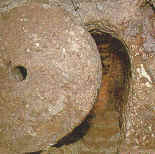|
|
Violent eruptions of the volcanoes Erciyes Dagi and Hasan Dagi three million years ago, covered the surrounding plateau with tuff. From the brittle rock the wind and rain have eroded Cappadocia's spectacular, surrealist landscape of rock cones, capped pinnacles and fretted ravines, in colors ranging from warm reds and gold to cool greens and grays.
Cappadocia is one of those rare regions in the world, where the works of man blend unobtrusively into the landscape. Dwellings are known to have been hewn from the rock as far back as 400 BC, when Xenophon mentioned them in his Anabasis.
During Byzantine times, chapels and monasteries were hollowed out of the rock, and their ochre toned frescoes simply reflect the hues of the surrounding landscape. Even today, troglodyte dwellings in rock cones and village houses of volcanic tuff merge harmoniously into the landscape.
The most interesting sites of the region include the rock chapels of Goreme, the troglodyte village of Avcilar, the red-coned monastic complex of Zelve, villages of Ortahisar and Uchisar clustered around rock pinnacles, the canyon of Ihlara and underground cities of Kaymakli and Derinkuyu. The center of the region are the town of Nevsehir and the village of Uegup.
On the fringe of the volcanic plateau are the cities of Kirsehir, Kayseri and Nigde, all once centers of Seljuk Turks, whose arts add different dimension to the region. It is intriguing that just as the region was the center for the development of Christian monasticism in 4th century, so too is proved fertile area for the development of Islamic mysticism, science and art.
Two humanitarian Moslem sects, Ahi Brotherhood and Bektashi Dervishes, originated in Kirsehir and Hacibektas respectively, and several interesting buildings associated with these sects can still be seen.

Derinkuyu
|
|

